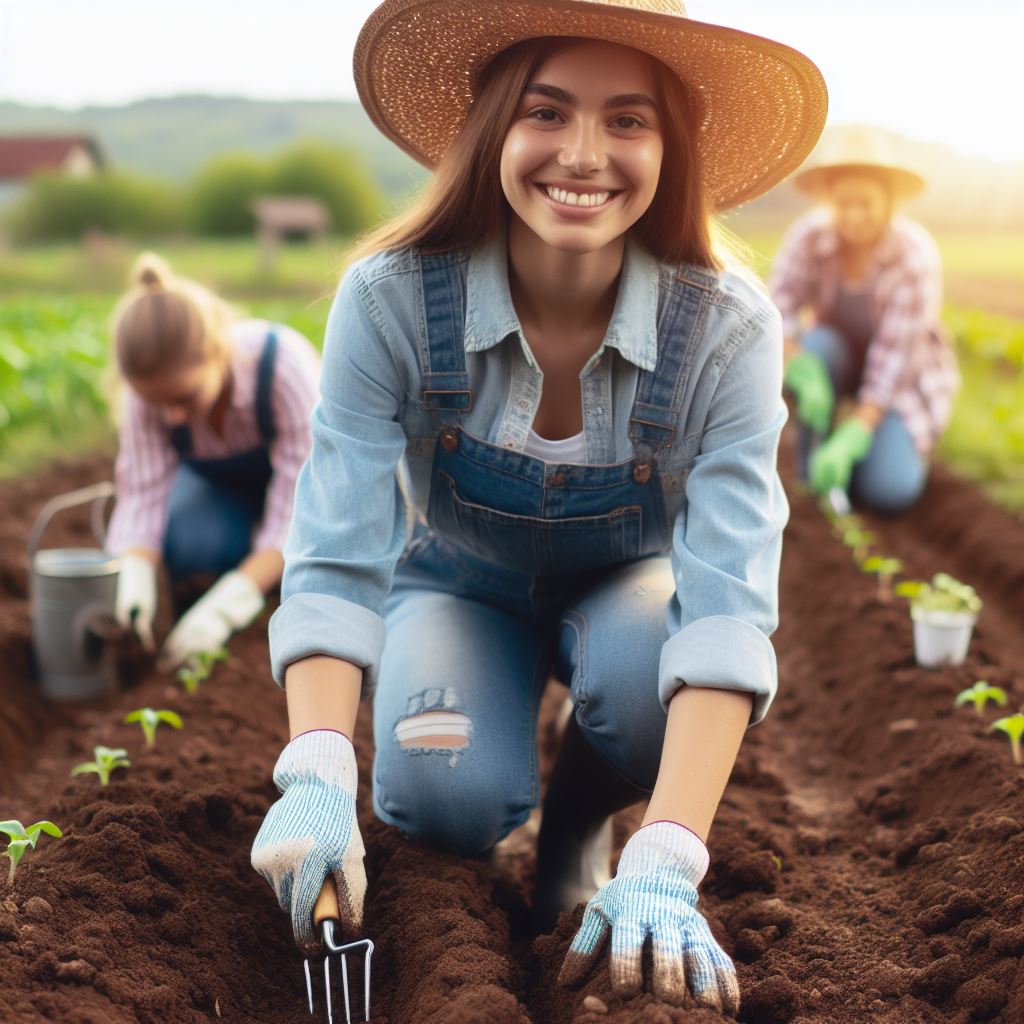Introduction
Definition of heritage crops
Heritage Crops Farmer Preservation, heritage crops, also known as heirloom crops, refer to traditional plant varieties that have been cultivated and passed down by farmers through generations.
Unlike modern hybrid or genetically modified crops, heritage crops retain their original genetic makeup and have been preserved for their unique traits, flavors, and adaptability to local environments.
These crops often have historical significance, representing the agricultural practices of bygone eras and the cultural heritage of communities.
Importance of heritage crops for farmers
For farmers, heritage crops play a crucial role in preserving biodiversity and genetic diversity in agriculture.
These crops often exhibit traits such as disease resistance, drought tolerance, and flavor profiles that are well-suited to specific climates and soil conditions.
By cultivating heritage crops, farmers contribute to the conservation of rare and endangered plant varieties, ensuring that valuable genetic resources are not lost to industrial monoculture practices.
Moreover, heritage crops offer economic opportunities for farmers by catering to niche markets that value authenticity, flavor, and sustainability.
Many consumers seek out heirloom fruits, vegetables, and grains for their unique taste and nutritional qualities, creating demand for farmers who specialize in heritage crop production.
Additionally, cultivating heritage crops can help farmers reduce their reliance on synthetic pesticides and fertilizers, promoting environmentally friendly farming practices.
Purpose of the blog post
The purpose of this blog post is to highlight the significance of heritage crops in agriculture and the importance of preserving these traditional plant varieties.
Through exploring the definitions and importance of heritage crops for farmers, readers will gain a deeper understanding of why these crops are essential for sustainable farming practices and the preservation of agricultural heritage.
Historical Significance of Heritage Crops
Overview of traditional farming practices
Traditional farming practices date back thousands of years and are deeply rooted in our history.
These practices involve cultivating and growing crops using natural methods, without the use of modern technology or synthetic inputs.
They have played a crucial role in sustaining human civilizations and preserving biodiversity.
Role of heritage crops in early agriculture
Heritage crops, also known as heirloom crops, are an integral part of traditional farming systems.
These crops have been handed down from generation to generation, preserved and grown for their historical significance and unique traits.
They are authentic, open-pollinated seeds that have not been genetically modified.
Examples of heritage crops and their historical significance
- Amaranth, a staple for Aztecs and Incas, boasts high nutrition and drought tolerance, cultivated for leaves, grains, and flowers.
- Quinoa, sustaining Andean communities, offers complete protein and thrives in harsh environments, vital for food security.
- Purple Corn, with cultural significance, was utilized by the Inca civilization for chicha morada, known for anthocyanin-rich kernels.
- Field Peas, resilient legumes, supply protein and nutrients, resisting pests and enriching soil fertility.
- Anasazi Beans, named after Native Americans, thrive in the arid Southwest, prized for flavor and nutrition.
- Heirloom Tomatoes, diverse in shape and color, retain exceptional taste, passed down for generations.
- Hopi Blue Corn, cherished by the Hopi tribe, holds cultural significance, valued for its color and versatility.
- Scarlet Runner Beans, vibrant red, attract pollinators, valued ornamentally and culinarily for generations.
- Landrace Wheat, locally adapted, evolves in response to environmental conditions, offering resilience and unique flavors.
- Benne, grown since slavery, integral to African American cuisine, carries cultural significance in the southern United States.
In general, preserving heritage crops ensures biodiversity and connects us to our agricultural past, promoting sustainable farming.
Read: Sustainable Practices: A Farmer’s Journey
Maintaining Biodiversity
Impact of modern industrial agriculture on crop diversity
- The focus on high-yielding crops has led to a dramatic reduction in the number of crop varieties.
- This has resulted in a loss of genetic diversity, making crops more vulnerable to pests and diseases.
- In addition, the use of pesticides and chemical fertilizers has further contributed to the decline in biodiversity.
- Monoculture practices have dominated agricultural landscapes, pushing out traditional and heirloom crops.
Importance of heritage crops in preserving biodiversity
- Heritage crops are traditional varieties that have been cultivated by farmers for generations.
- By growing heritage crops, farmers help maintain a diverse range of plant genetic resources.
- These crops possess unique and valuable traits that can contribute to future food security.
- Preserving biodiversity ensures resilience in the face of changing climatic conditions.
Advantages of growing heritage crops for farmers
- Heritage crops are often well-suited to local environmental conditions, reducing the need for chemical inputs.
- They have adapted to pests and diseases over time, making them more resistant and requiring fewer pesticides.
- Heritage crops can also fetch higher prices in niche markets, providing additional income opportunities for farmers.
- Furthermore, cultivating diverse crops can enhance soil health and reduce erosion.
- By growing heritage crops, farmers can preserve their cultural and agricultural heritage, passing it on to future generations.
Basically, the impact of modern industrial agriculture on crop diversity has been detrimental to our food systems and ecosystems.
However, the cultivation of heritage crops offers a solution to preserve biodiversity and provide numerous benefits for farmers.
By embracing these traditional varieties, we can build more resilient and sustainable agricultural practices for a better future.
Read: Vertical Farming: Highs and Lows
Cultural Preservation
Connection between heritage crops and cultural identity
- Heritage crops play a crucial role in preserving cultural identity as they reflect the farming practices and culinary traditions of a particular community.
- Cultivating and consuming heritage crops allows individuals to maintain a connection to their ancestral roots and contributes to a sense of belonging.
- Farmers who grow heritage crops often pass on their knowledge and techniques to future generations, ensuring the preservation of cultural heritage.
- By supporting the cultivation of heritage crops, communities can celebrate and showcase their unique cultural identities, fostering a sense of pride and unity.
Role of heritage crops in traditional recipes and cuisine
- Heritage crops are essential ingredients in traditional recipes and cuisine, adding distinct flavors, textures, and aromas.
- These crops have been used for centuries to create signature dishes that are an integral part of a culture’s culinary heritage.
- In many communities, traditional recipes handed down through generations rely on specific heritage crops that are irreplaceable.
- Incorporating heritage crops into modern cooking not only preserves cultural traditions but also adds depth and authenticity to the culinary experience.
Contributions of heritage crops to local festivals and celebrations
- Heritage crops often take center stage in local festivals and celebrations, showcasing their importance in cultural traditions.
- Farmers and community members proudly display and share their heritage crops during these events, educating others about their significance.
- Local festivals focusing on heritage crops promote cultural exchange and appreciation among different communities.
- These celebrations provide an opportunity for people to learn about and appreciate the diversity and richness of agricultural practices and cultural traditions.
In a nutshell, heritage crops play a crucial role in cultural preservation by connecting communities to their cultural identity, contributing to traditional recipes and cuisine, and enriching local festivals and celebrations.
As farmers continue to cultivate and preserve these crops, they ensure the survival of centuries-old farming practices and culinary traditions for future generations.
Supporting the cultivation and consumption of heritage crops is not only an act of preserving cultural heritage but also a way to celebrate and embrace the diversity and richness of human traditions.
Read: High-Rise Gardens: Urban Farming in Chicago

Environmental Benefits
Comparison of heritage crops with genetically modified crops
Heritage crops offer significant environmental benefits when compared to genetically modified crops.
While genetically modified crops have been genetically engineered to withstand pesticides, heritage crops maintain their natural genetic diversity and do not require genetic modifications.
This lack of genetic modification ensures the preservation of genetic heritage and promotes biodiversity.
Positive impact of heritage crops on soil health
One of the most notable advantages of heritage crops is their positive impact on soil health.
These crops help maintain soil fertility by effectively cycling nutrients and minimizing soil degradation.
Unlike genetically modified crops, heritage crops often require fewer synthetic fertilizers and pesticides, contributing to healthier soil and reducing groundwater pollution.
Furthermore, some heritage crops possess deep root systems that prevent soil erosion and improve water infiltration.
This characteristic helps maintain soil structure and reduces the risk of nutrient runoff into water bodies.
By preserving soil health, heritage crops play a crucial role in sustaining agriculture while minimizing negative environmental impacts.
Transform Your Agribusiness
Unlock your farm's potential with expert advice tailored to your needs. Get actionable steps that drive real results.
Get StartedReduction of chemical inputs and the preservation of natural resources
In addition to benefiting soil health, heritage crops also contribute to the reduction of chemical inputs and the preservation of natural resources.
Due to their genetic diversity, heritage crops exhibit better resistance against pests and diseases compared to genetically modified crops.
As a result, farmers can rely less on synthetic chemicals to protect their crops, reducing their environmental footprint.
The decreased use of synthetic chemicals also has wider environmental implications.
By minimizing chemical interventions, heritage crops safeguard the surrounding ecosystem and protect wildlife from potential harm.
This approach ensures the preservation of a balanced and healthy environment for both humans and other species.
Another aspect of heritage crops’ environmental benefits lies in the preservation of natural resources.
Conserving resources such as water and energy is essential for sustainable agriculture.
Heritage crops often require less irrigation, making more efficient use of water resources.
Additionally, these crops do not rely on genetically modified traits that require substantial energy inputs for production and processing, making them an environmentally responsible choice.
In closing, the environmental benefits of heritage crops arise from their non-GMO nature, positive impact on soil health, reduction of chemical inputs, and preservation of natural resources.
These crops preserve genetic diversity and promote biodiversity, maintain soil fertility, reduce the use of synthetic chemicals, and contribute to the conservation of water and energy resources.
By embracing heritage crops, farmers can actively contribute to sustainable agriculture and environmental preservation.
Read: Rooftop Farm Magic: An NYC Urban Farmer’s Tale
Challenges and Solutions
Limited market demand for heritage crops
- Lack of consumer awareness can lead to a limited market demand for heritage crops.
- Farmers can educate consumers about the benefits of heritage crops through marketing campaigns.
- Exploring niche markets such as farmers’ markets and specialized grocery stores can increase demand.
- Collaborating with restaurants and chefs to create unique dishes using heritage crops can also boost demand.
- Building partnerships with local businesses and promoting the health benefits of heritage crops can attract more consumers.
Farming techniques and methods specific to heritage crops
- Farmers face challenges in finding and accessing specific seeds or cultivars of heritage crops.
- Seed libraries and exchanges can be established to ensure a wider availability of heritage crop seeds.
- Farmers can adapt traditional farming practices and techniques for better cultivation of heritage crops.
- Research and development institutions can provide training and resources to farmers for heritage crop cultivation.
- Sharing knowledge and experiences among farmers through farmer networks and workshops can improve farming techniques.
Collaboration with local communities and organizations for promotion
- Farmers can work closely with local communities and organizations to create awareness about heritage crops.
- Hosting community events and workshops can educate people about the importance of preserving heritage crops.
- Engaging in partnerships with local schools and educational institutions to incorporate heritage crop education into the curriculum.
- Collaborating with tourism boards to promote heritage crop farms as tourist attractions.
- Encouraging consumers to become directly involved in heritage crop cultivation through community-supported agriculture programs.
In fact, while heritage crop farming comes with its unique set of challenges, there are several solutions available to overcome these hurdles.
By addressing the limited market demand through education and promotion, developing farming techniques specific to heritage crops, and collaborating with local communities and organizations, farmers can ensure the preservation and viability of these crops for future generations.
Economic Opportunities
Niche markets for heritage crops
- Heritage crops have the potential to tap into niche markets due to their unique characteristics.
- These crops can attract consumers who are looking for authentic, traditional, and locally grown products.
- Niche markets include restaurants, farmers markets, gourmet stores, and specialty food stores.
- By targeting these markets, farmers can sell their heritage crops at higher prices, increasing their profits.
Value-added products from heritage crops
- Heritage crops can be used in the production of value-added products such as sauces, jams, and pickles.
- These products can attract a wider range of consumers and help increase the demand for heritage crops.
- By adding value to the raw crops, farmers can earn more income and extend the lifespan of their harvest.
Sustainable income generation through heritage crop cultivation
- Heritage crop cultivation presents an opportunity for farmers to generate a sustainable income.
- Unlike conventional crops that face price fluctuations, heritage crops are often in demand and command higher prices.
- This stability in pricing ensures a steady income for farmers, reducing their financial risks.
- Additionally, heritage crops can be grown using organic and sustainable methods, attracting environmentally conscious consumers.
- By cultivating these crops, farmers can cater to niche markets and attract customers who are willing to pay a premium for quality and sustainability.
In short, heritage crops offer various economic opportunities for farmers.
These crops can tap into niche markets, attracting consumers who seek authentic and locally grown products.
By selling their crops to restaurants, farmers markets, and specialty food stores, farmers can command higher prices and increase their profits.
Furthermore, heritage crops can be transformed into value-added products, expanding their market appeal and potentially increasing demand.
By producing sauces, jams, and pickles, farmers can earn additional income and prolong the shelf life of their harvest.
Most importantly, heritage crop cultivation offers a sustainable income generation opportunity.
These crops have stable pricing and can be grown using organic and sustainable methods, attracting environmentally conscious consumers.
Overall, heritage crops present an exciting venture for farmers looking to diversify their income streams and preserve traditional agricultural practices.
Conclusion
Heritage crops hold paramount importance for farmers in various ways.
Firstly, these crops carry cultural and historical significance, preserving traditions and connecting farmers to their past.
Additionally, the cultivation of heritage crops fosters biodiversity, ensuring sustainable practices and the availability of diverse food options.
Considering the numerous benefits, farmers are encouraged to explore the cultivation of heritage crops as a viable option.
By diversifying their crops, farmers can tap into niche markets, increase profitability, and contribute to the preservation of traditional farming practices.
However, a call to action is necessary for the widespread preservation and promotion of heritage crops.
It is crucial for farmers, consumers, and policymakers to collaborate in developing policies that prioritize heritage crops.
This includes providing financial support, creating educational programs, and raising awareness about the value of heritage crops.
By collectively embracing the cultivation and consumption of heritage crops, we can empower farmers, preserve cultural heritage, and promote sustainable farming practices.
Let us work together to ensure the continuation and prosperity of these invaluable crops for future generations.




